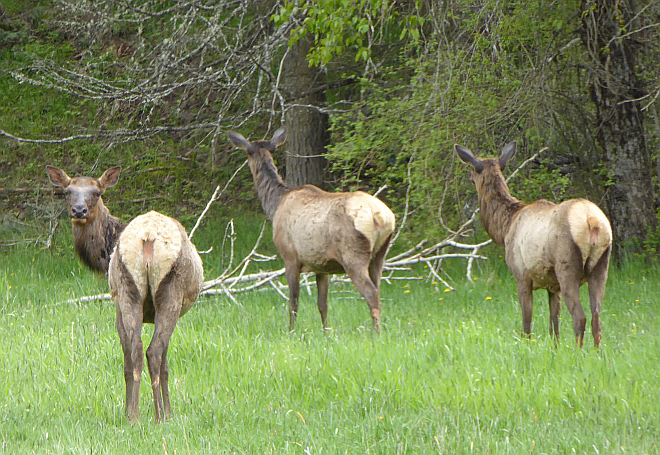|
Fall will bring more elk tags, fewer mule deer |
|
March 20, 2017 |
 |
Story and photo by Roger Phillips
IDFG Public Information Specialist
Hunters will see fewer hunting opportunities for
mule deer does in the fall, but more controlled
hunts for elk, particularly cow elk.
Idaho Fish and Game commissioners on Thursday,
March 17 set the hunting seasons for deer, elk,
bear, pronghorn, mountain lion and wolf. The
rules will be available online and in print in
mid April.
Idaho Fish and Game has been monitoring herds
this winter and expects the lowest survival of
mule deer fawns in 18 years. By mid March, about
50 percent of the mule deer fawns wearing radio
collars have died, and more are expected to die,
but doe survival was tracking about 95 percent
for that time.
Fish and Game’s deer and elk coordinator Craig
White said in response to winter weather impact
on mule deer fawns , antlerless harvest for mule
deer will be reduced in 2017 and 2018 hunts.
There will be fewer antlerless and either-sex
controlled hunts, and less hunting opportunity
for youths to harvest mule deer does in units
across most of southern Idaho. Statewide, deer
hunters will get about 1,600 fewer controlled
hunt deer tags. The decrease in mule deer tags
will actually be greater than that. For example,
Fish and Game is decreasing either-sex mule deer
tags in southern Idaho by 2,045 tags, however,
some of that is offset by increased by
controlled hunt tags for whitetails.
Elk have fared better and because previous years
mild winters helped grow elk herds, hunters will
see added opportunity for cow elk hunting in
both controlled hunts and general hunts.
Radio-collar data shows statewide, about 76
percent of calves survived to mid March and
about 98 percent of radio-collared cows were
still alive.
Statewide elk populations should be similar to
last year, and growing elk herds in certain
areas have exceeded F&G’s population objectives
and are causing problems on private lands.
“To get back to our objectives, we need to
reduce the cow segment of those populations,”
White said.
Overall, F&G is adding 1,460 more controlled
hunt tags for elk, which includes another 375
antlerless elk tags. It’s also adding general
season hunting for cow elk in the Weiser River
Zone and in the Panhandle Zone.
White explained expanded cow hunting is to
reduce herds around private lands, and also to
restore long-time cow hunting opportunities in
the Panhandle that were reduced years back to
help herds increase.
Similar problems with elk depredating on private
lands are occurring in portions of the Salmon
Region and in the Pioneer Elk zone, and hunting
opportunity has been expanded to address it, as
well some controlled deer hunts around
agriculture lands.
While some mule deer hunting opportunities have
been cut back, White pointed out that most areas
north of the Salmon River had a different
winter, and white-tailed deer should survive
winter in good numbers.
In recent years, whitetails typically account
for about 40 to 45 percent of the total deer
harvest with mule deer making up the remainder.
Mule deer hunters will face a combination of
fewer opportunities to harvest does and fewer
young bucks available in the fall. Of last
year’s estimated 39,000 mule deer harvest, about
20 percent, or 8,000 of the mule deer harvested,
were does.
Because of high winter fawn mortality, hunters
can expect fewer two-point and spike bucks next
fall, which made up 28 percent of the total
harvest and 35 percent of the antlered harvest
in 2016.
“In general, we’re going to see a lot fewer
yearlings in the harvest than we’ve seen in the
last 4 years,” White said.
Fish and Game does not radio collar bucks in the
same numbers as does and fawns, but because
mature bucks survive at rates close to that of
does, biologists expect many adult bucks will
make it through the winter. |
|
Questions or comments about this
article?
Click here to e-mail! |
|
|
|
|

